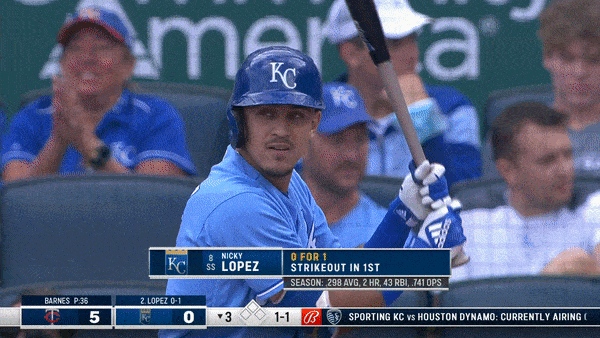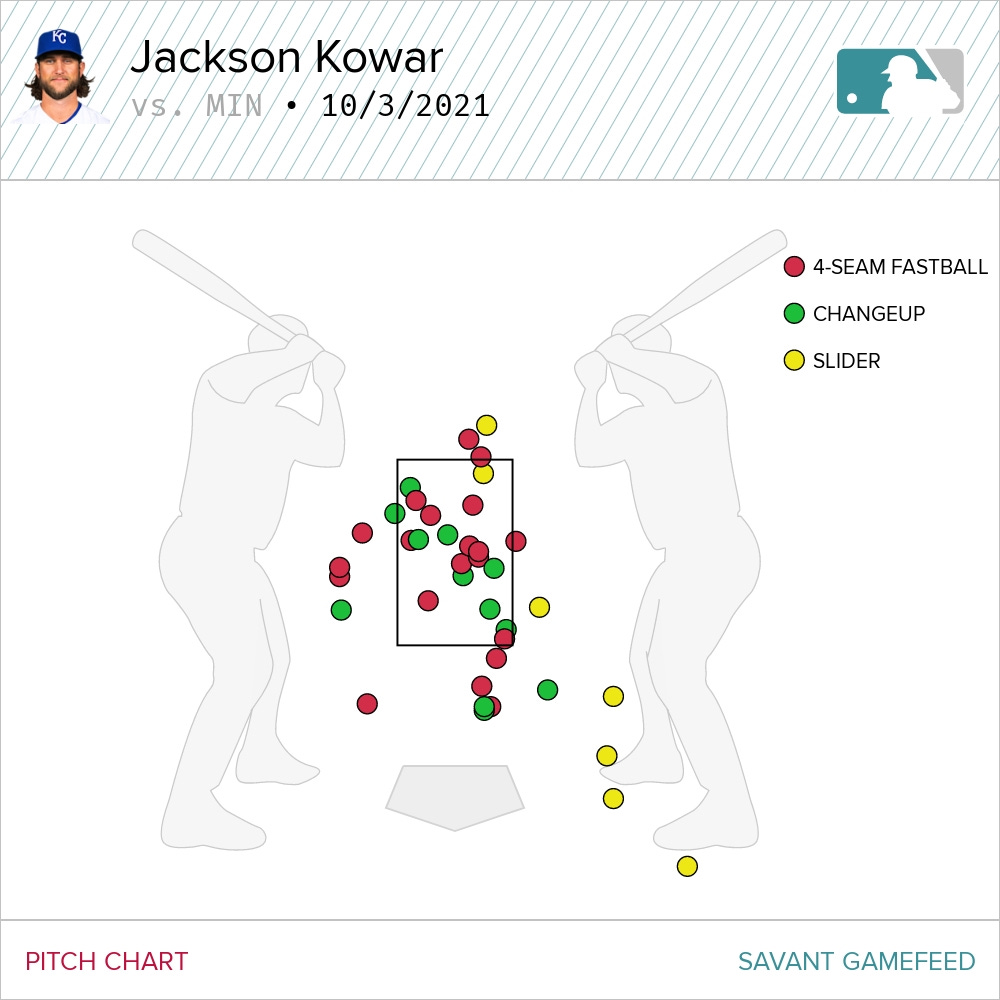Bringing down the curtain on 2021
Salvy is homerless, Lopez hits his mark and Kowar stumbles out of the gate once again as the Royals drop the finale.
With a 7-3 loss to the Minnesota Twins, another Royals season comes to a close. By finishing with 74 wins, it was a year that matched most expectations, and it was punctuated by some impressive individual performances.
Despite the record, this was a fun team to watch. Sometimes frustrating, often entertaining (in both good and bad ways), the 2021 Royals provided us with another soundtrack to our summer. The young arms arrived with varying (and wildly inconsistent) degrees of success and the young bats raked across the minor league system. There are will undoubtedly be some stumbling blocks ahead, but it’s easy to feel optimistic about the future.
Thank you
I’d like to open today’s edition with a heartfelt note of thanks. Thank you for visiting and thank you for subscribing. When this venture started last winter, it came without any kind of expectations on my part…mainly because I had no idea about what I was getting into. It was extremely gratifying to see the clicks and subscriber base steadily increase as the season rolled along. Almost all of that growth is through the digital world’s version of word of mouth: Likes and shares and retweets and whatnot. So thank you for helping get the word out about this newsletter.
Also, I’d like to thank my pal, Colby Wilson, for his contributions every Thursday. I look forward to his weekly takes and hope you do, too.
Please, continue to share and continue to read. I’m not going anywhere this offseason. I’ll be doing some postseason work at Baseball Prospectus and have some fun things planned for the newsletter. (A lot of Salvy content will be sent.) The inaugural season of Into The Fountains was a success. Why stop now?
Did Salvy hit a home run?
Sadly, he did not.
In fact, he ended his season on quite the down note. After falling down the dugout stairs and spraining his right ankle in the Cleveland game on September 29—just after hitting home run number 48—Perez went 1-15 with six strikeouts. I wouldn’t go so far as to say his ankle was the cause for the absence of production over the final four games. His cuts looked healthy, even if his ankle wasn’t. Maybe a little too healthy. Oftentimes swinging out of his shoes, Perez sure looked like a man who realized time was running short on his quest for the Royals’ all-time single-season home run record.
It’s understandable.
Perez hit 10 home runs through May. He picked up the pace a bit in June and July, then really kicked on the afterburners in August. A whopping 22 of his 48 dingers came in the season’s final two-plus months. That’s an amazing binge, especially for a player whose previous career-best was 27 home runs. We knew the single-season Royals’ record and all those catcher home run totals were in sight once the calendar flipped to September, but up to that point, it was a long shot that he would hit those marks. Yet expectations change given previous results. So it was, having passed Johnny Bench as having the greatest power-hitting season by a catcher in the history of the majors, Perez was chasing down franchise infamy.
So he’s tied with Jorge Soler. So he came up just short of 50 home runs. So he finished tied for the major league lead with Vladimir Guerrero Jr. So what?
Just because Perez doesn’t own titles or records or just because he didn’t finish with a tidy round number, his season is in no way diminished. Perez finished with a 126 OPS+ and a .544 slugging percentage, both career bests for a full season. Oh yeah, speaking of full seasons…the guy played in 161 games, the majority of which were as a backstop. Come on! This was, hands down, one of the most impressive power-hitting seasons in the recent history of the game.
Nicky Lopez, Professional Hitter
While Salvy impressed by unleashing a power show in the second half of the season, I probably had the most fun watching Nicky Lopez’s evolution this year. Can’t help it…there’s something about a guy who is down and out yet catches a break and then capitalizes. Think about it…Lopez was ticketed for Omaha after basically losing his starting job with a miserable spring. He was added to the roster just ahead of Opening Day and by the time the guy he replaced was finally healthy enough to play, they moved that guy off his original position to keep Lopez at short. Just a phenomenal—and completely unexpected—season.
He capped it off on Sunday by finishing with a cool. 300 batting average. Look, long-time readers know…I don’t really care about batting average. Perhaps I should amend that. I don’t really care about batting average when trying to measure the production of a hitter. There are much better ways to accomplish this. Still, there’s something fun about certain numbers. That’s part of what makes baseball, baseball. And batting .300 is one of those.
Honestly, I was feeling nervous for Lopez after his average dipped to .299 after Saturday’s game. If he played the entire game, he was going to need two hits to get back, but he collected that one hit he needed in his second at bat—in classic Lopez style—and came out of the game for a pinch-runner. And as a .300 hitter.
You know what, I’m absolutely fine with Mike Matheny removing him once he hit that mark. Lopez was hitting .257 on June 26 with .347 OBP. In the 82 games after that point, Lopez hit .325 with a .376 OBP. He posted a 3.2 fWAR, tied for 13th best in the majors over the season’s second half. That’s fire.
The year is such a grind, for Lopez to make that kind of offensive stride over the final three months was just something to savor. So hell yeah, hit that .300 mark and get out of the game. He earned every stinking point on that batting average.
Abolish the first
I wish I had something clever to write about Jackson Kowar, but holy moly how brutal is that first inning for him?
I wrote about his first inning struggles in-depth last week so I might as well update it with his first inning pitch chart from Sunday.
Center-cut fastballs, sliders that had no hope of hitting the strike zone and hanging changeups. Yep, it’s all there. And the Twins absolutely punished him. Six batters reached base before he was able to record an out.
The good news is (yes, there is some good news), after that debacle, Kowar retired 12 in a row with six of those coming via the strikeout.
The good news is (yes, there is some good news), after that debacle, Kowar retired 12 in a row with six of those coming via the strikeout. Sure, part of that can be attributed to the Twins just getting aggressive in the box and trying to get to the end of their disappointing season. But Kowar did pitch better once he started recording outs. He was working the edges a little more and his fastball command was present which allowed him to set up his slider and his changeup. He finished with a 29 percent CSW%, which is quite good, given how he opened the game. Two of the whiffs were on his slider, two on his change and six came on the four-seamer. He also spun a lone curve and got a whiff on that.
Kowar, while winning the Royals’ organization minor league pitcher of the year award, did not have a good first year in the majors. After his return when the rosters expanded, he allowed five runs in four of his last five starts. The lone start where he didn’t allow five runs, he surrendered six. Overall, he finishes with an 11.27 ERA in 30.1 innings covering nine appearances (eight starts). Twenty of the 31 runs he allowed as a starter came in the first inning.
There’s a lot of work to be done, but there’s also some promise in that arm.
Games 162
What a kick in the pants these final games were. We needed either the Yankees or Red Sox to lose to give us some bonus baseball and instead both rallied for late victories, rendering all the other results moot. The Mariners were fun in a kind of unexpected, overachieving way, but damn do you have to feel for the Blue Jays. That’s a team that would’ve really messed up someone’s October if they had found a way to get into the tournament.
Instead, we get another chapter in the Red Sox and Yankees rivalry that I’m sure has everyone on the east coast properly juiced. I imagine the suits at ESPN are having their own champagne celebration today. Can’t say I’m one of those people who will join in the rivalry lovefest. Instead, I’ll choose to look at the bright side. At least one of those teams will be eliminated after Tuesday.
The Royals finished fourth in the AL Central, three behind Detroit and a game ahead of Minnesota. Their .457 winning percentage is 11th out of 15 American League teams and 21st out of 30 Major League teams. Meaning, they’ll pick ninth in next summer’s draft. (Pending no radical changes to the new CBA that I don’t even want to think about at the moment.)
They were in first as late as May 5, but dropped out of the lead with the fifth defeat in what would become a season-torpedoing 11 game losing streak. They settled into fourth place in the AL Central on June 28 and except for a few days they spent in the cellar, that was where they hung out for the rest of the season.
In strong parallels to the early years of Ned Yost’s managerial tenure, the Royals have improved on their winning percentage in each of the last three seasons.
2018 — .358
2019 — .364
2020 — .433
2021 — .457
There’s still plenty of work to be done and honestly, a year-over-year improvement doesn’t really matter, but it is nice to see a positive trend. The challenge is to keep that trend going.
Up next
The Cactus League opens play for the Royals on February 26 when they play their complex-mates, the Texas Rangers. The Royals start the 2022 season on the road against the Cleveland Guardians on March 31.
Start the countdown…178 days until Opening Day.








Thank you Craig for writing this newsletter every morning. The first thing I read when I am up and moving is your post. I am anxious to see what happens this winter with the CBA and also the construction of the 2022 team. It should be an interesting winter.
Thank you, Craig (and Colby) for the work you put in this year! As always, it's a pleasure reading you.